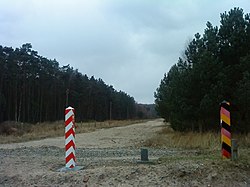Battle of the Oder–Neisse
| Battle of the Oder–Neisse | |||||||
|---|---|---|---|---|---|---|---|
| Part of the Eastern Front of the Second World War | |||||||
 A modern view of the Oder-Neisse line at Usedom |
|||||||
|
|||||||
| Belligerents | |||||||
|
|
|
||||||
| Commanders and leaders | |||||||
|
|
|
||||||
The Battle of the Oder–Neisse is the German name for the initial (operational) phase of one of the last two strategic offensives conducted by the Red Army in the Campaign in Central Europe (1 January – 9 May 1945) during World War II. Its initial breakthrough phase was fought over four days, from 16 April until 19 April 1945, within the larger context of the Battle of Berlin. The Soviet military planners divide the frontal and pincer phases of the operation, named Berlin Strategic Offensive Operation into:
The battle included heavy fighting by the three Fronts of the Marshals of Soviet Union Konstantin Rokossovsky's 2nd Belorussian Front, Georgy Zhukov's 1st Belorussian Front and Ivan Konev's 1st Ukrainian Front, that assaulted the defending Wehrmacht Army Group Vistula commanded by Colonel-General (Generaloberst) Gotthard Heinrici and Field Marshal Ferdinand Schörner's Army Group Centre.
Most of the fighting took place during 1st Belorussian Front's assault on the Seelow Heights, that were defended by the German 9th Army (part of Army Group Vistula), in what became known as the Battle of the Seelow Heights. 1st Ukrainian Front encountered much lighter resistance crossing the Neisse to penetrate defensive lines of Army Group Centre.
In the early hours on 16 April 1945, the Berlin Strategic Offensive Operation began with a massive bombardment by thousands of artillery pieces and Katyusha rockets in a barrage which was sustained for as long as two hours on some sectors of the front. Shortly afterwards and well before dawn, the 1st Belorussian Front attacked across the Oder, and the 1st Ukrainian Front attacked across the Neisse. The 1st Belorussian Front was strengthened because it had the more difficult assignment and was facing the majority of the German forces in prepared defences.
...
Wikipedia
